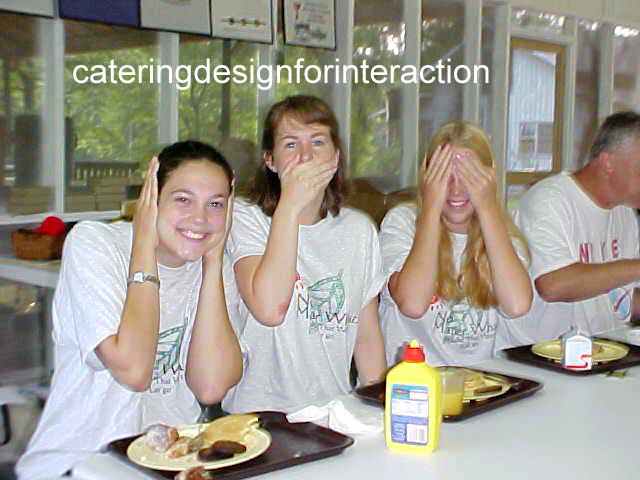catering design is written in preparation of the Design Recast symposium, organized by the Jan van Eyck Academie design department, 12-14 April 2002, Maastricht, the Netherlands.
Its current state features:
basic network lay-out
new information habits
wild attention dynamics
design's traditional qualities
highly performative media
well furnished everyday
catering design
jouke kleerebezem
'Now and in the past, most of the time the majority of people live by borrowed ideas and upon traditional accumulations, yet at every moment the fabric is being undone and a new one is woven to replace the old, while from time to time the whole pattern shakes and quivers, settling into new shapes and figures. These processes of change are all mysterious uncharted regions where the traveller soon loses direction and stumbles into darkness. The clues to guide us are very few indeed: perhaps the jottings and sketches of architects and artists, put down in the heat of imagining a form, or the manuscript brouillons of poets and musicians, crisscrossed with erasures and corrections, are the hazy coastlines of this dark continent of the "now", where the impress of the future is received by the past.'
(from: George Kubler, The Shape of Time; remarks on the history of things (1962), Yale University Press, isbn 0-300-00144-4; p17-18)
Over the last decades, digital communication and information technologies have catalysed developments in design which aim to answer to the changing ways in which people communicate, share information and acquire knowledge. First with the advent of the personal computer in the 1970s, the opening of the Internet to consumers in the early 1990s and the following explosion in mobile telecommunication—adding the rise of popular digital audio-visual production—today the network society has a basic lay-out and mode of interaction for large parts of the world.
'Old' media consequently reorganize and review different functions, to the extent of who to address with which information, in which format. Rather than the 'death' of print, the newspaper, magazine and book, new information habits have woken up those older media to a vast diversity of special interests, some of which simply can not be met in electronic communication. High resolution, high tactility, computer independent interaction, immediate (local) visibility, shared access and direct participation—to name a few, are significant qualities which are greatly appreciated in contemporary design and art, resulting in exciting products, events, knowledge, interaction.
Our information and communication contexts acknowledge new social cultural relationships, between possibly dislocated but definitely interest sharing parties. Sharing information on a local and global scale, person-to-person recommendation, increasing mobility and economic flexibility are just some of the effects of contemporary networked communication. Recent developments appear often 'spectacular', in both a literal as well as in a more historical critical sense. Mass media and industrial powers grapple for market share in fragmenting trades, while opposing cultural interests and alternative distribution fight for their right to be public, democratic and uncensored. With these wild attention dynamics, both 'information' and 'noise' abundance can distract or even intimidate a contemporary 'user', particularly if no ruling editorial and design patterns are developed. However, rather than a fixed set of new limitations, or a new authoritative 'school' in design, or aesthetic belief system—rather than new absolutes, also an abundance of rules and formats informs all expressions in cultural production today. Patterns do emerge, but even these seem to remain dynamic, never to settle in a dominant configuration... and if at times being appreciated as the 'next big thing', certainly not for very long, as competing next big things today tend to queue up infinitely.
Evidently for readability and usability patterns we have to look for different stratifications and articulations in information organization and representation, rather than for previously ruling patterns, which attempted to fix and prescribe meaning, while preselecting audiences through discrimination and in various paternalistic ways. For the design disciplines, to be answerable to current modes of communication and information, and to be innovating in both their functionality and expression, it will take extensive research and experimentation, equally in laboratory and in real world contexts. Topical questions bear upon how design can accommodate and emphasize egalitarian information access and communication concerns; how it enhances readability and usability of new knowledge formats and structures; how it operates in intricate network logistics, which allow for 24/24 person-to-person audio-visual and textual exchange; how it bridges cultural differences with full respect to political identity and idiosyncratic social preference—in short: how design can best perform its traditional qualities of guiding people's information sharing acts, allowing to advance communication abilities, by enhancing their literacy and improving the expression of their interests.
In a highly performative media industry, designers are expected by their commissioners to position themselves not just as knowledgeable and technically skilled facilitators, to shape up clear existing messages or products, answering to obvious communication demands, for distinct target audiences. Instead, they increasingly conceive of messages and products from an early stage onwards, finding themselves in a variety of influential roles. With their commissioners they invent new messages, new products, indeed whole new businesses, and last but not least: the audiences to go with these 'experiences', as is the latest design challenge commonly referred to today. Designers collaborate with other cultural producers, not seldom ending up self-commissioned, catering to their own audiences, obeying what is by some considered a star system, not unlike the ones existing in other popular media like music, film, or architecture.
For an extraordinary well furnished everyday, in which overly mediated special interests disguise as indispensable new products and services, designers and artists designing 'experience' (a.k.a. information, goods, services) belong to a new breed of entrepreneurs, catering to new generations of consumers. Design is all, all is design. Whether barricading with an anti-globalization movement or launching one's monograph in 8 different hard-cover editions, design samples them all: attitudes, slogans, media, experiences—as a first discipline to take mass customization serious, while having the full support of contemporary technology and media attention. (...) Under these circumstances traditional political choices between satisfying capital industry or supporting a counter-cultural alternative seem obsolete. Conservative and alternative markets converge, crossbreed and fragment into unexpected niche trades. Design, shaping the 'stuff that surrounds us', has become very visible, a mark of innovation, a popular, even streetwise, language and convincing selling point added value. Such observations can never be illustrated enough—both to demonstrate their true actuality, as to relativize their often too conclusive obviousness.
(to be continued, in 'performance design')
correspondence: change@idie.net
Jouke Kleerebezem, idie.net: Innovation and Design for Information Empowerment 2002


